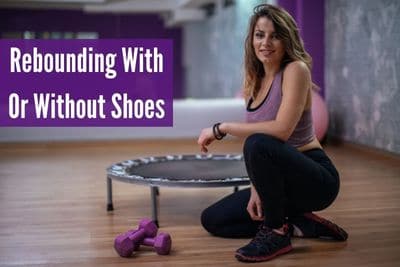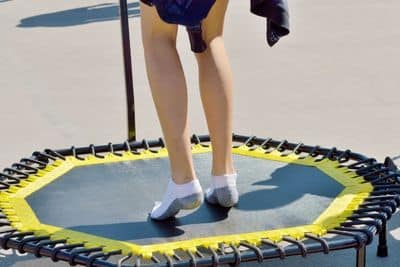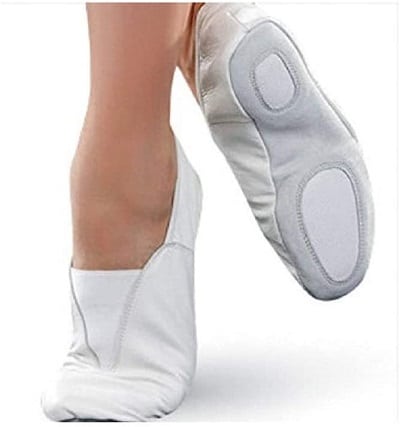People rebound trampolines either barefoot or using shoes or socks. So, you might fall into a dilemma- what is the best practice for rebounding shoes or without shoes?
Rebounding barefoot is ideal in most cases as it provides a better grip and has more control on the trampoline or rebounder. But socks, shoes, or sneakers might be helpful to jump properly for some people. So, whether you put on or off the shoes before rebounding depends on the jumpers’ physical condition.
Today, I’ll explain all the facts related to rebounding barefoot vs shoes vs socks, so you get a clear idea of which is right for you. Let’s get started!
What to Do: Wearing Shoes or No Shoes While Rebounding?

What is the best way of rebounding workouts barefoot or wearing shoes, sneakers, or socks? It depends on the strength of the ankle, workout intensity, and a few more things.
The following discussions will help you understand whether you should be on or off shoes while rebounding.
Read Also: Can I rebound before bedtime?
a) Can You Workout Without Shoes on a Trampoline?
Is it okay to exercise on a rebounder without shoes? Yes, barefoot rebounding is ideal for trampolines and rebounders. 95 % of people have good ankles. For them, barefoot jumping is better compared to wearing shoes.
Here are some reasons why you should rebound without shoes or sneakers.
What are the Benefits of Barefoot Rebounding?
- While rebounding barefoot, you touch the jumping surface directly; thus, you will get a better balance. It’s like walking barefoot that provides better traction and stability. So, barefoot trampolining helps elderly people to have good balance without losing control and falling to the ground.
- Going barefoot means touching the dirt in the jumping bed will stimulate your nervous system as well as improves immunity.
- Jumping barefoot is natural that will give you more fun. No shoe rebounding doesn’t make your feet heavy; thus, you can jump happily and comfortably.
- Barefoot jumping doesn’t prone to sweating, so there is no chance of slipping while trampolining.
- People with diabetes may suffer from different foot diseases. But keeping their feet on the ground will help them greatly to enjoy a healthy life.
Read Also: Various benefits of rebounding
Is There Any Risk of Rebounding Barefoot?
If you plan to rebound for a longer period, jumping on a trampoline bare feet might cause pain in your feet. Thus, you might take some rest after doing exercise for a while to mitigate the soreness. Rebounding without shoes in this situation for a long might be harmful to you.
Also, if you are suffering from a previous joint or knee problem, trampolining barefoot might harm your feet. So, it’s wise to avoid rebounding without trampoline shoes or socks.
Read Also: Negative side effects of rebounding

b) Can You Wear Shoes on a Trampoline?
Can you jump on a trampoline with shoes? In general, it’s not recommended to wear shoes while jumping on the trampoline, but it may be necessary in some cases. For those who want to do high-intensity trampoline workouts, rebounder sneakers will be a good option for sore-free jumping. Shoes or sneakers are also the right choices for jumping on uneven surfaces.
Benefits of Wearing Shoes on a Trampoline?
Studies show that 5% of people have bad ankles and need extra support during fancy rebounding. If you have such joint pain, trampoline exercise shoes will give great support hence comfortable rebounding. But you have to choose the right exercise boot as most shoes are prone to damage the trampoline mat.
Soft and mat-friendly shoes CrossFit sneakers and running shoes are two recommended options for trampolining and rebounding. These specially designed rebounder shoes won’t create any strain on jumpers’ feet and won’t damage the mat harshly.
Trampoline sneakers also provide good traction for slip-free bouncing. Flat feet people also get these workout boots handy for maintaining balance.
Read Also: Different trampoline types
Reasons to Avoid Wearing Shoes During Rebounding
Whether it’s good or bad to use shoes on a trampoline is a big debate. But, if you want to wear shoes during rebounding, several things should be kept in mind.
- Rebounding workout shoes might damage the trampolines hence reducing their lifespan.
- This will hinder your balance and flexibility as the sole is harder, so it might be awkward sometimes to land properly.
- Jumping with shoes has a higher risk of injury than rebounding without shoes. If you land on a weird angle, it could be a reason for sprained or broken ankle.
Read Also: Which rebounder is perfect for exercise?
c) Can You Wear Socks on a Trampoline?
Undoubtedly, barefoot jumping is the best way of rebounding, but trampoline socks are also used sometimes for jumping on the trampoline or rebounder. Actually, slip-resistant trampoline socks are the right alternative to bare feet rebounding.
Rebounder socks are used when the jump mat is too warm or very cold. They also prevent sweating, thus ensuring slip-free jumping and ensure better traction.
If the trampoline bed has any black material, socks also protect your feet, so these don’t do that. Jumping socks are mandatory for trampoline parks to stop fungus infection.
But regular socks aren’t recommended as they are not fully slip-resistant. They may also cause static electricity buildup that could be injuries if you bang off the frame or fall to the ground.
What are the Best Shoes for Trampoline Workout?
Here are two recommended best shoes for rebounding. You can choose any pair from the list to make your trampoline jumping comfortable.
01. MEDUSA ENT LLC Rubber Sole Gymnastic Trampoline Shoes

Medusa Gymnastic Trampoline Shoe is designed for good ankle support and comfortable rebounding. The lightweight material makes rebounding easier.
The upper part of the shoe is made from leather. Its front panel is elasticized for proper flexibility. Around the top back of the shoes, there is an elastic strap to hold the feet in place.
Both kids and adults, sizes are available. Just choose the right size and rebound happily. So, don’t miss these soft trampoline shoes.
Read Also: What clothes to wear to a trampoline park?
02. Joyfay Unisex Fitness Jumping Rebounder Shoes

Joyfay Trampoline Fitness Jumping Shoes are designed for gymnasts to rebound for a longer period. The sneakers use plastic material that makes the product lightweight. It also uses spring to feel you the experience of floating in the air.
The bounce shoes provide low-impact exercise and reduce joint stress. It also burns more than 20% of calories. Other benefits include burning fat, improving the lymph system, developing metabolism, supporting the cardiovascular system, fighting osteoporosis, and many more.
The unisex rebounder sneakers fit both males and females; just match your size.
FAQs on Rebounding With or Without Shoes
1. How to measure your foot before rebounder shoe size choice?
Ans: It’s just measuring foot length and width using a tape measure. To measure the length of your feet, measure the distance from the tip of your big toe to your heel. Again, measure the widest distance of your foot. You can take each measurement 2 to 3 times for more accurate results.
Read Also: Are trampolines safe for toddlers?
2. What to look for when choosing trampoline shoes?
Ans: Rebounder shoes or sneakers should fit your feet well. Make sure they provide good ankle support. Two comfortable types of shoes for rebounding and trampoline are CrossFit shoes and runners’ shoes. Both of them provide good traction and ankle support.
Final Words
Barefoot jumping is a natural way to rebound on a trampoline. Rebounding barefoot is better than wearing shoes or socks, as this provides proper traction and balancing.
But if you have a bad ankle or the mat is too warm or cold, or you want to exercise for a long period, trampoline shoes or socks will be the right choice.
Hopefully, you can now decide rightly rebounding with or without shoes which is suitable for you. Enjoy rebounding!

Rebecca is a fitness nerd and mother. She was inspired to get into the world of trampolining and rebounding by her husband Robert, who is a well-respected trainer and expert in the field. Now she instructs children, mothers, and teens the basic trampolining and rebounding tricks.
Rebecca is also a passionate blogger, sharing her knowledge and experiences with others in the hope of encouraging them to give trampolining and rebounding a try.
